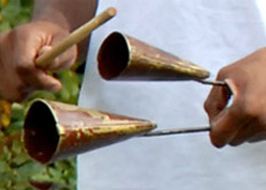capoeira art form
One of the translations of the word Capoeira found in Michellis Brazilian Portuguese-English dictionary is “wrestling with legs”.
Its physical aspects are reflected in other martial arts and various dance styles, especially those created in recent years, but Capoeira isn't just a physical exercise…
capoeira - a national sport of brazil
Capoeira nowadays is a national sport of Brazil, however its origin is controversial. There is a dominant trend among historians and anthropologists that Capoeira emerged in Brazil as a result of a process of acculturation occurred among Africans, Indians and Portuguese.
Since the eighteenth century subject to state prohibition, Capoeira found shelter in small groups of practitioners in states in the southeast and northeast of Brazil. There were different manifestations of dance-fight. In the 1970s expansion was initiated at the national level and in 1980, international.
what is 'capoeira'?
Although there are several meanings of the word "capoeira", each referring to objects, animals, people, or situations, in sports terms, it is a game of dexterous body, using legs, arms and head, practiced in pairs, based on attacks, dodges and insinuations to the sound of songs and musical instruments (berimbau, atabaque, pandeiro, agô-gô and reco-reco).
Focused on its origins as a dance-fight, Capoeira has developed into an art form with elements of
- gymnastics,
- dance,
- sports,
- martial art,
- music,
- folklore,
- recreation,
- theatre,
It inspired many artists around the world, including painters and musicians, because it is a whole culture with elements of movements, music, tradition, history and language. Who opens their heart and mind to Capoeira enters another world, a world united in passion for the art form and the same language. Unless one tries Capoeira personally, one cannot really understand it.
The language is not just the spoken one, Portuguese, which one learns while practising Capoeira through the songs and the names of the movements. It's also the language where the moves themselves become words. One wouldn't say they fight, one plays a Capoeira game. That game is a conversation with questions and answers. It takes place within a circle called ‘Roda’, created by musicians and those watching the game and singing the chorus.
philosophy behind the movements & the game
There are and there are not set movements in Capoeira. Some schools emphasise certain movements, other focus on others. If one wants to progress well, follow their school's style and code of conduct then one has to be patient. It is important to realise that Capoeira gives back what one puts into it.
Some people are well coordinated and find physical exercise and learning movements very easy, but some do not. Also there are those who have always exercised and those who have never done any sport before. It is nearly insignificant though how fit or stretched one is and how well one does the movement. 'Well' in this art form is very subjective. What matters is the willingness to learn Capoeira and within the game itself, how the movement is used in a Roda in order to answer a question asked by the other player, or to outwit the opponent and show the superiority of ones knowledge of the art form.
In general, there are really no winners in Capoeira game unless during specially organised competitions. The players explore the knowledge they gain through training and their aim is to surprise the opponent and not to be surprised.
Experience, gained through years of training, is equally important. A Capoeira Master using just few movements is easily able to outsmart younger, physically stronger and faster Capoeira students with less experience.
The movements themselves also vary amongst the schools. ‘Negativa’ in one school might look quite different to ‘Negativa’ in another, but it doesnít mean that in one of those places it is taught wrongly. It's just different, according to the school's tradition and roots. Even the movements' names might vary amongst Academies.
music
One participates in a Roda by:
- playing a game inside the Roda
- playing the instrument, or
- sitting/standing in a Roda and answering the chorus in reply to a leading singer.
None of those should be forgotten while learning the Capoeira art form.
Music in Capoeira is crucial. There is no Capoeira game without it.
Singing, playing instruments and clapping are all very important aspects of training and are regularly implemented in Capoeira classes.
A beginner, even someone who speaks Portuguese, starts learning the rhythm first, then the basic single words, eventually songs comes much easier and one is interested and encouraged to learn to play an instrument. Often, people find singing in front of others intimidating, but they are not isolated and realising that, and having a go is really rewarding.
Songs are mostly sung in Brazilian Portuguese. Those interested in the art form, but have no or very little knowledge of the language, usually after some time of regular training begin to understand more.
instruments in capoeira
In our style, a Roda consist of 8 musicians. They play:
- 3 berimbaus (a single-string percussion instrument, a musical bow, from Brazil),
- 2 pandeiros (tambourines),
- agô-gô (cow-bell),
- reco-reco (scraper), and
- atabaque (drum).
Training Capoeira also means learning to play all ofthe above instruments.
portuguese in capoeira
It is not necessary to be fluent in Portuguese in order to carry on with the art form for many years, but it makes it easier to research the original Brazilian resources and communicate with Brazilian Masters and other artists within Capoeira. However, for somebody who studies Capoeira for few years, learning Portuguese is just a natural part of progression within the art.





